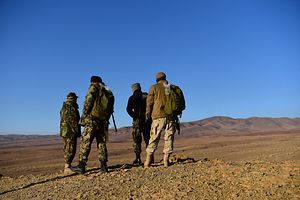The Pentagon is developing plans to withdraw up to half of the 14,000 American troops serving in Afghanistan, U.S. officials said Thursday, marking a sharp change in the Trump administration’s policy aimed at forcing the Taliban to the peace table after more than 17 years of war.
One official said the troops could be out by summer, but no final decision has been made.
President Donald Trump has long pushed to pull troops out of Afghanistan, considering the war a lost cause. But earlier this year, he was persuaded by Defense Secretary Jim Mattis and other military leaders to keep troops on the ground to pressure the Taliban and battle a stubborn Islamic State insurgency. Officials said the latest White House push for withdrawal was another key factor in Mattis’ decision to resign Thursday.
The officials spoke on condition of anonymity to discuss internal deliberations.
U.S. troops stormed into Afghanistan in November 2001 in an invasion triggered by the September 11 attacks perpetrated by al-Qaeda. At the time, the extremist network led by Osama bin Laden used Afghanistan — led by the Taliban since 1996 — as a base of operations.
Since 2001, America has lost more than 2,400 soldiers in Afghanistan and spent more than $900 billion on its longest war. Three U.S. presidents have pledged to bring peace to Afghanistan, either by adding or withdrawing troops, by engaging the Taliban or shunning them, and by struggling to combat widespread corruption in the government.
The U.S. and NATO formally concluded their combat mission in 2014, but American and allied troops remain, conducting strikes on the Islamic State group that established a presence in eastern Afghanistan and the Taliban and working to train and build the Afghan military. By the end of October 2018, U.S. forces had released a record 5,982 weapons from manned and unmanned aircraft, surpassing 2010’s previous record of 5,101.
Taliban insurgents, however, control nearly half of Afghanistan and are more powerful than at any time since a 2001 U.S.-led invasion. They carry out near-daily attacks, mainly targeting security forces and government officials.
In August 2017, Trump unveiled what his administration termed its South Asia Strategy. In remarks at the time, Trump said, “Conditions on the ground — not arbitrary timetables — will guide our strategy from now on.” While campaigning Trump had made clear his disdain for his predecessors’ withdrawal plan, despite making statements as far back as 2012 that “It is time to get out of Afghanistan.”
In recent months, however, there has been a renewed effort to make progress on peace talks with the Taliban. In September, former U.S. ambassador to Afghanistan and Iraq, Zalmay Khalilzad — who also served as U.N. ambassador — was named Trump’s special representative for Afghanistan reconciliation. In the three months since, Khalilzad has been on a whirlwind tour, touching base with allies, partners and other parties invested in the Afghan war. On December 19, Khalilzad completed what he called a “productive” three days of meetings in the UAE, “with Afghan and international partners to promote intra-Afghan dialogue towards ending the conflict in Afghanistan.”
Officials now worry that any move to withdraw U.S. troops in the coming months could dampen the prospects of reaching a peace agreement and simply encourage the Taliban to wait it out until they can take advantage of the gaps when the forces leave.
Afghanistan is scheduled to hold presidential elections in April 2019.
By Lolita C. Baldor for Associated Press, with additional reporting from The Diplomat.

































